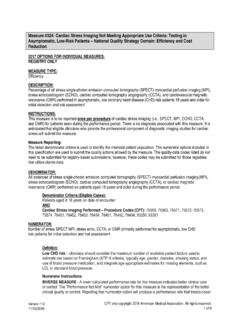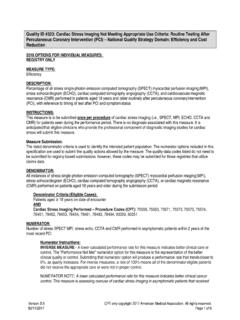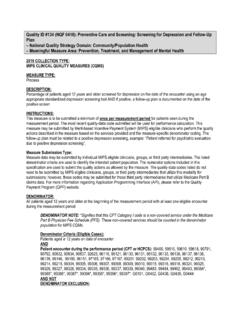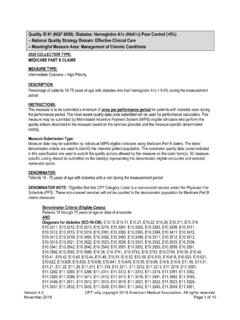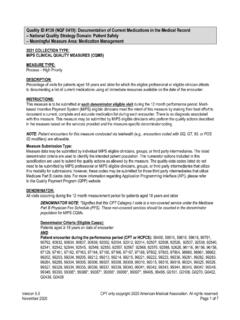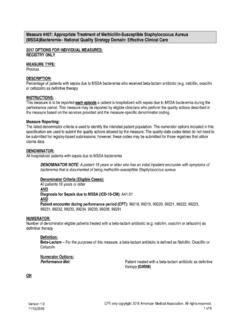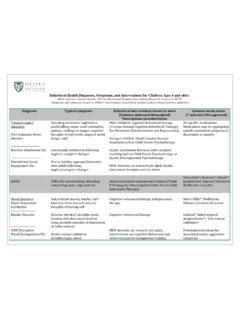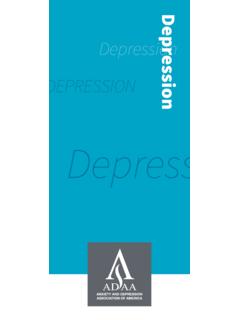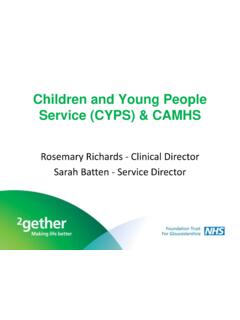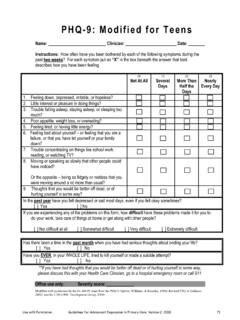Transcription of Quality ID #134: Preventive Care and Screening: Screening ...
1 Version CPT only copyright 2020 American Medical Association. All rights reserved. November 2020 Page 1 of 10 Quality ID #134: Preventive care and Screening : Screening for Depression and Follow-Up Plan National Quality Strategy Domain: Community/Population Health Meaningful Measure Area: Prevention, Treatment, and Management of Mental Health 2021 COLLECTION TYPE: MIPS CLINICAL Quality MEASURES (CQMS) MEASURE TYPE: Process DESCRIPTION: Percentage of patients aged 12 years and older screened for depression on the date of the encounter or up to 14 days prior to the date of the encounter using an age-appropriate standardized depression Screening tool AND if positive, a follow-up plan is documented on the date of the eligible encounter INSTRUCTIONS: This measure is to be submitted a minimum of once per measurement period for patients seen during the measurement period.
2 The most recent Screening submitted will be used for performance calculation. This measure may be submitted by Merit-based Incentive Payment System (MIPS) eligible clinicians who perform the Quality actions described in the measure based on the services provided and the measure-specific denominator coding. The follow-up plan must be related to a positive depression Screening , example: Patient referred for psychiatric evaluation due to positive depression Screening . NOTE: Patient encounters for this measure conducted via telehealth ( , encounters coded with GQ, GT, 95, or POS 02 modifiers) are allowable. Measure Submission Type: Measure data may be submitted by individual MIPS eligible clinicians, groups, or third party intermediaries.
3 The listed denominator criteria are used to identify the intended patient population. The numerator options included in this specification are used to submit the Quality actions as allowed by the measure. The Quality -data codes listed do not need to be submitted by MIPS eligible clinicians, groups, or third party intermediaries that utilize this modality for submissions; however, these codes may be submitted for those third party intermediaries that utilize Medicare Part B claims data. For more information regarding Application Programming Interface (API), please refer to the Quality Payment Program (QPP) website. DENOMINATOR: All patients aged 12 years and older at the beginning of the measurement period with at least one eligible encounter during the measurement period Definition: Not Eligible for Depression Screening or Follow-Up Plan (Denominator Exclusion) Patients who have been diagnosed with depression- , , , , , , , , , , , , , , , , , , , , , , , , , , , , , , Patients who have been diagnosed with bipolar disorder- , , , , , , , , , , , , , , , , , , , , , , , , , , DENOMINATOR NOTE.
4 The intent of the measure is to screen for depression in patients who have never had a diagnosis of depression or bipolar disorder prior to the eligible encounter used to evaluate the numerator. Patients who have ever been diagnosed with depression or bipolar disorder will be excluded from Quality ID #134: Preventive care and Screening : Screening for Depression and Follow-Up Plan National Quality Strategy Domain: Community/Population Health Meaningful Measure Area: Prevention, Treatment, and Management of Mental Health Version CPT only copyright 2020 American Medical Association. All rights reserved. November 2020 Page 2 of 10 the measure. *Signifies that this CPT Category I code is a non-covered service under the Medicare Part B Physician Fee Schedule (PFS).
5 These non-covered services should be counted in the denominator population for MIPS CQMs. Denominator Criteria (Eligible Cases): Patients aged 12 years AND Patient encounter during the performance period (CPT or HCPCS): 59400, 59510, 59610, 59618, 90791, 90792, 90832, 90834, 90837, 92625, 96105, 96110, 96112, 96116, 96125, 96136, 96138, 96156, 96158, 97161, 97162, 97163, 97165, 97166, 97167, 99078, 99202, 99203, 99204, 99205, 99212, 99213, 99214, 99215, 99304, 99305, 99306, 99307, 99308, 99309, 99310, 99315, 99316, 99318, 99324, 99325, 99326, 99327, 99328, 99334, 99335, 99336, 99337, 99339, 99340, 99401*, 99402*, 99403*, 99483, 99484, 99492, 99493, 99384*, 99385*, 99386*, 99387*, 99394*, 99395*, 99396*, 99397*, G0101, G0402, G0438, G0439, G0444 AND NOT DENOMINATOR EXCLUSION: Documentation stating the patient has had a diagnosis of depression or has had a diagnosis of bipolar disorder.
6 G9717 NUMERATOR: Patients screened for depression on the date of the encounter or up to 14 days prior to the date of the encounter using an age-appropriate standardized tool AND if positive, a follow- up plan is documented on the date of the eligible encounter Definitions: Screening Completion of a clinical or diagnostic tool used to identify people at risk of developing or having a certain disease or condition, even in the absence of symptoms. Standardized Depression Screening Tool A normalized and validated depression Screening tool developed for the patient population in which it is being Examples of standardized depression Screening tools include but are not limited to.
7 Adolescent Screening Tools (12-17 years) Patient Health Questionnaire for Adolescents (PHQ-A), Beck Depression Inventory-Primary care Version (BDI-PC), Mood Feeling Questionnaire (MFQ), Center for Epidemiologic Studies Depression Scale (CES-D), Patient Health Questionnaire (PHQ-9), Pediatric Symptom Checklist (PSC-17), and PRIME MD-PHQ-2 Adult Screening Tools (18 years and older) Patient Health Questionnaire (PHQ-9), Beck Depression Inventory (BDI or BDI-II), Center for Epidemiologic Studies Depression Scale (CES-D), Depression Scale (DEPS), Duke Anxiety- Depression Scale (DADS), Geriatric Depression Scale (GDS), Cornell Scale for Depression in Dementia (CSDD), PRIME MD-PHQ-2, Hamilton Rating Scale for Depression (HAM-D), Quick Inventory of Depressive Symptomatology Self-Report (QID-SR), Computerized Adaptive Testing Depression Inventory (CAT-DI), and Computerized Adaptive Diagnostic Screener (CAD-MDD) Perinatal Screening Tools Edinburgh Postnatal Depression Scale, Postpartum Depression Screening Scale, Patient Health Questionnaire 9 (PHQ-9), Beck Depression Inventory, Beck Depression Inventory II, Center for Epidemiologic Studies Depression Scale, and Zung Self-rating Depression Scale Follow-Up Plan Documented follow-up for a positive depression Screening must include one or more of the following.
8 Referral to a practitioner who is qualified to diagnose and treat depression Pharmacological interventions Version CPT only copyright 2020 American Medical Association. All rights reserved. November 2020 Page 3 of 10 Other interventions or follow-up for the diagnosis or treatment of depression Examples of a follow-up plan include but are not limited to: Referral to a practitioner or program for further evaluation for depression, for example, referral to a psychiatrist, psychologist, social worker, mental health counselor, or other mental health service such as family or group therapy, support group, depression management program, or other service for treatment of depression Other interventions designed to treat depression such as behavioral health evaluation, psychotherapy, pharmacological interventions, or additional treatment options Patients with a Documented Reason for not Screening for Depression (Denominator Exception) Patient Reason(s) Patient refuses to participate OR Medical Reason(s)
9 Documentation of medical reason for not Screening patient for depression ( , cognitive, functional, or motivational limitations that may impact accuracy of results; patient is in an urgent or emergent situation where time is of the essence and to delay treatment would jeopardize the patient s health status) Numerator Instructions: A depression screen is completed on the date of the encounter or up to 14 days prior to the date of the encounter using an age-appropriate standardized depression Screening tool AND if positive, a follow-up plan must be documented on the date of the encounter, such as referral to a practitioner who is qualified to treat depression, pharmacological interventions or other interventions for the treatment of depression.
10 Depression Screening is required once per measurement period, not at all encounters. An age-appropriate, standardized, and validated depression Screening tool must be used for numerator compliance. The name of the age-appropriate standardized depression Screening tool utilized must be documented in the medical record. The depression Screening must be reviewed and addressed in the office of the provider on the date of the encounter. Positive pre- Screening results indicating a patient is at high risk for self-harm should receive more urgent intervention as determined by the provider practice. The Screening should occur during a qualifying encounter or up to 14 days prior to the date of the qualifying encounter.
